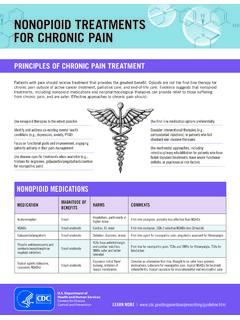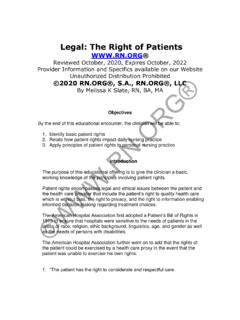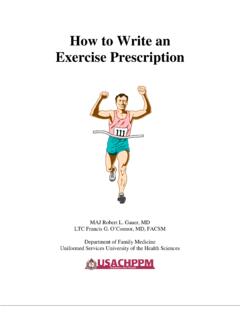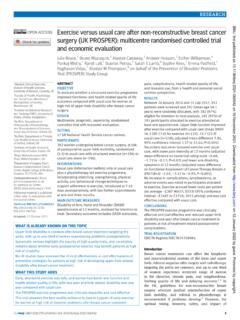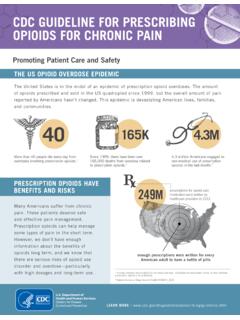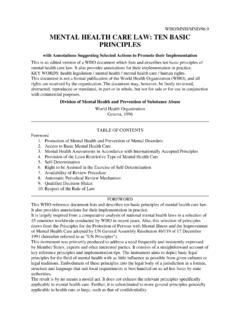Transcription of AACVPR Guidelines for Pulmonary Rehabilitation …
1 AACVPR Guidelines forAACVPR Guidelines forPulmonary RehabilitationPrograms (4thEdition) Gerene Bauldoff, PhD, RN, FAACVPRG erene Bauldoff, PhD, RN, FAACVPRThe Ohio State UniversityDISCLOSURE INFORMATIONDISCLOSURE INFORMATIONS ession DescriptionSession Description This session will provide a review ofThis session will provide a review of the 4th edition of the recently published P lR h bilit ti(PR) Pulmonary Rehabilitation (PR) Guidelines and evidence-based outcomes for Identify the changes in the pulmonaryIdentify the changes in the Pulmonary Rehabilitation guideline dtirecommendations Describe how evidence-based outcomes can be applied to PR programming Co-Editors:Co-Editors: Richard ZuWallack, MD and Rebecca H.
2 Crouch, PT, DPT, CCS* Linda Nici MDCh i GRN MSN NP*Writing Committee MembersLinda Nici, MD Bonnie Fahy, RN, MN* Paula Meek, PhD Chris Garvey, RN, MSN, NP* Kathleen Stewart, PT, DPT, CCS Joseph Norman, PT, PhD, CCS SuzanneLareau, RN, MSN Carolyn Rochester, MD Jonathan Raskin, MD Gerilynn Connors, BS, RRT* Lana Hilling, RCP, RRT* Jane Reardon RN MSN CS*, Neil MacIntyre, MD*Jane Reardon, RN, MSN, CS * = FAACVPR Interdisciplinary group of writers: PhysiciansInterdisciplinary group of writers: Physicians, Nurses, Physical Therapists, Respiratory Therapists exercise PhysiologistsTherapists, exercise Physiologists Nationally recognized experts in the field of Pulmonary RehabilitationPulmonary Rehabilitation A primary author navigated each chapter i iitirevision or writing All chapters reviewed by the writing committee and several outside reviewers Writing committee met on 5 occasions over 2 gyears to complete the bookChapter 1: Overview of PR Chapter 1: Overview of PR Definition or PRDefinition or PR ACCP/ AACVPR Evidence-based PR Guidelinesbased PR Guidelines summaryHi tf P l History of Pulmonary Rehabilitation Chapter 2.
3 Selecting and Assessing the PR Candidate Conditions appropriate for PRConditions appropriate for PR Patient assessment:Interview Pain assessment ADL assessment Interview Medical historyDiti t tADL assessment Nutrtion assessment Educational assessment Diagnostic tests Symptom assessmentMlkltldEducational assessment Psychosocial assessment Musculoskeletal and exercise assessment Goal development and Rehabilitation potentialrehabilitation potentialChapter 2: Common Conditions Leading to PR Referral Dyspnea, fatigue, and chronic respiratory symptoms Impaired health-related quality of life Decreased functional performancedilf Decreased occupational performance Difficulty performing ADLs Difficulty with medical regimenDifficulty with medical regimen Psychosocial problems related to underlying respiratory illness Nutritional depletion Increased us of medical resources: hospitalizations, ED, MD visits Gas exchange abnormalities including hypoxemiaChapter 3.
4 Collaborative Self-Management Education Developing an individualized Developing an individualized educational programEdtilt t Educational content Useful internet web site ddaddresses Sample document for self-management educationmanagement education Sample of COPD action planEnd of life planning End of life planningChapter 3: Sample Educational TopicsChapter 3: Sample Educational Topics Normal physiology/pathophysiology NutritionIiidphysiology/pathophysiology Medical test interpretation Breathing strategies Irritant avoidance Exacerbation recognition and management Breathing strategies Secretion clearanceMdi ti(i ldimanagement Leisure activitiesTravel and oxygen Medications (including oxygen) Respiratory devices Travel and oxygen Sexuality Coping with chronic disease Respiratory devices Benefits of exercise ADLsCoping with chronic disease End of life planning ADLsChapter 4.)
5 exercise Assessment and Training Types of exercise testsyp Testing forms exercise assessment equipmente c se assess e t equ p e t Functional performance assessment Mechanisms of exercise intolerance in chronic respiratoryMechanisms of exercise intolerance in chronic respiratory disease Rationale for exercise training in chronic respiratory diseasegpy Emergency procedures Documentation Preparing the home exercise programChapter 4: exercise Assessmentp Goal:Quantify exercise capacity before beginning program Quantify exercise capacity before beginning program Establish baseline for outcomesHelps to determine patientspecific goals Helps to determine patient-specific goals exercise prescriptionDetect e erciseind ced h po emia; O2 titration Detect exercise -induced hypoxemia.
6 O2 titration Evaluate for non- Pulmonary exercise limitationsD t td l idibliti Detect underlying cardiac abnormalities Screen for exercise -induced bronchospasmChapter 4: Assessment Testsp Walk distance tests 6MW Shuttle walk Incremental maximal test Submaximal exercise testSubmaximal exercise test Functional performance assessmentChapter 4: Incremental Maximal exercise Test Performed on treadmill or stationary bicyclestationary bicycle Ramped or incremental increases in exercise load ( 15-25 (watts/min) Symptom-limited testing criteria: Ventilatory limits Gas exchange limits Cardiovascular limits Other limits Musculoskeletal, metabolic, peripheral uscu os e eta ,etabo c, pe p e avascular, psychologicalChapter 4: exercise Trainingpg Skeletal muscle dysfunction is a key factor iiilin exercise intolerance Physical deconditioning is consequence of ygqmore sedentary lifestyle to avoid dyspneaLeads to downward spiral Leads to downward spiral Rationale of exercise addresses the skeletal muscle dysfunction Supervised exercise addresses patient s fear ofSupervised exercise addresses patient s fear of dyspneaChapter 4.)
7 Principles of Exercisepp Encompass both upper-extremity and lower-extremity endurance trainingendurance training Aerobic exercise at high or low intensity Strength trainingStrength training ? Respiratory muscle training Duration, frequency, intensity of exercise should be included in exercise prescriptionincluded in exercise prescription 3-5 times/week for 4-12 weeks Ultimate goal of 30 minutes endurance exercise within couple weeks of beginning programChapter 4: exercise Typespyp Upper- and lower-extremity trainingN d tild i ADL Need to exercise muscles used in ADLs Lower-extremity training involves large muscle groupsWlkittibik ti li biii Walking, stationary bike, stair climbing, swimming Improves ambulatory stamina, balance and ADL performance Upper-extremity training improves arm muscle Upper-extremity training improves arm muscle endurance and strength Support (arm ergometry) or unsupported (dowel rod)pp(gy)pp() Can trigger dysynchronous breathing Caution in patients with osteoporosis (increased risk for thit bft)dtthit i tthoracic vertebrae fracture) and post-thoracic surgery pateints (usually none before 6 weeks post-operatively) Chapter 4.
8 exercise Typespyp Strength training improves muscle strengthExamples: Examples: Hand and ankle weights, free weights, machine weights, elastic resistance, and own body weight (stair climbing, squats)Sihli hdhi hii Start with lower weights and higher repetitions Cautious progression in weights for safety Flexibility posture and body mechanics Flexibility, posture and body mechanics Goal to increase range of motion, improve balance Respiratory muscle trainingRespiratory muscle training Not supported by ACCP/ AACVPR Guidelines as essential to PR Types include flow resistive devices, threshold loading training, and isocapneic hyperventilationChapter 5: Psychosocial Assessment and Intervention Prevalence of psychosocial concerns in the chronic Prevalence of psychosocial concerns in the chronic respiratory disease population Assessment of psychosocial concerns Assessment of psychosocial concerns Screening for depression and anxiety MotivationMotivation Self-efficacy Interventions for psychosocial concernsInterventions for psychosocial concerns Building support system Section addressing smoking cessationgg Pharmacology and nicotine replacement therapies Chapter 5.
9 Psychological Assessment Toolspyg Depression Geriatric Depression Scale (GDS) 15 item tool, yes/no questions, 5 or greater triggers further evaluation Center for Epidemiological Studies Depression Scale (CES-D) 20-item tool, 0 (rarely) to 3 (most of the time) scale, score<16 normal, 16-2420item tool, 0 (rarely) to 3 (most of the time) scale, score 16 normal, 1624 indicates borderline drepressive symptoms, > 24 triggers immediate referral Anxiety: Frequently present with depression General anxiety disorder 7 (GAD-7) 7-item tool, 0-3 scale; 8thquestion re: distress of symptoms; >5 indicates mild anxiety, >10 triggers referral Penn State Worry Questionnaire (PSWQ-A) 16-item tool, 1-4 scale; <30 normal for 16 item version Cognitive impairment Cognitive impairment Mini-mental state examinationChapter 6: Patient Centered Outcomesp Outcome areas for Pulmonary patients Timing and analyzing outcomes Timing and analyzing outcomes Common outcome measurement tools Table of dyspnea measures Table of dyspnea measures Table of HRQoL measuresOthiblt Other possible outcome measures Functional performance and home-based activity Patient adherencePatient adherence Weight modification Mortality Health care utilization Patient satisfactionChapter 6: Outcome ExamplesChapter 6.
10 Outcome ExamplesOutcomeAreas MeasuredTypes of MeasuresExercise capacityDistance walkedOxygen consumption6 MWShuttle walkExercise stress testSymptomsDyspneaFatigueSymptom-specif ic questionnairesDomainsof HRQoL orDomainsof HRQoL or functional status questionnairesHealthrelatedSeveral domainsvaries byGeneric questionnairesHealth-related quality of lifeSeveral domains,varies by questionnaire (physical function, emotional function mastery orGeneric questionnairesDisease-specificquestionna iresfunction, mastery or impact and symptoms)Chapter 6: Outcome Tool ExamplesppOutcomeTool ExamplesDyspneaBDI/TDI, Borg, UCSD SOBQ, VASF atigueBorg, CRQ fatigue subscale, PFSDQ-M subscale, VA SVA SHRQoL (Disease-specific)CRQ, SGRQ, SOLQHRQoL (Generic)SF-36 Chapter 6: Other OutcomesChapter 6: Other Outcomes Home-based activity Psychological outcomes Patient adherence Knowledge and self-efficacy Smoking cessation Smoking cessation Weight modification Health care utilization Mortalityy Patient satisfactionChapter 7.
